Boards in Tea: Ita
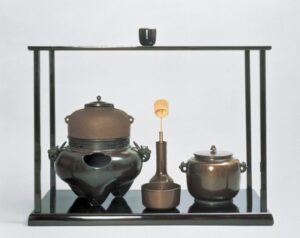
The dai-su, 台子, support-of, utensils display stand, is composed of a rectangular ji-ita, 地板, earth-board, and ten-ita, 天板, heaven-board, supported on four corner posts, which are identified with the four seasons. The daisu may be placed where it is needed. Water for tea is heated in a kama, supported on a portable brazier, fu-ro, 風炉, wind-hearth. Because the charcoal fire heats the furo, the furo is placed on the jiita to protect the tatami flooring. This is the model by which all portable braziers are employed, and although not called by its function, but is the origin on the shiki-ita, 敷板, spread-board.
The model for the daisu as well as the subsequent use of the shikiita has its origins in the early days in Japan. Typical domestic dwellings had bare wooden floors that were not covered with tatami. People generally sat on the wood floor or on circular, woven cushions, or on go-za, 御座, hon.-sit, straw mats which were folded up and stored when not in use. Such mats are also called uwa-shiki, 上敷き, up-spread. Folding is called tatameru, 畳める, which is the source of the word tatami. In time the mats were attached to the face of thick grass rigid mats which could be placed where needed.
The nobility sat on such tatami mats, and as their importance was recognized, additional mats were stacked one upon another. This is part of the origin of the raised floor of the tokonoma where the nobility could sit on two or more tatami which was above tatami that may have covered the floor of the adjoining room. Eventually, tatami covered the entire floor of the room, and was classified as a za-shiki, 座敷, sit-spread.
The general size of the goza was determined by the average size of a single person lying down, hence around three by six shaku, 尺, ‘feet’. Tatami are made in various sizes, with a standard of 3 x 6 shaku, and the size of a room is identified by the number of tatami. An average size room is the yo-jō-han, 四畳半, four-mat-half. In a way the room came first.
Yui-ma, 維摩, Rope-rub, known as Vimalakirti in Sanskrit, was a follower of the Buddha, and lived in a small hut that measured about ten feet square. This room size became a standard for Buddhist living quarters. Subsequently, the room was called a hō-jō, 方丈, direction-measure, approximately 10 shaku square, this is the approximate size of the yojōhan. The earliest yojōhan room devoted to the practice of Chanoyu is named, ‘Dō-jin-sai’, 同仁斎, Equal-benevolence-abstain, in the Tō-gu-dō, 東求堂, East-request-hall, of Gin-kaku-ji, 銀閣寺, Silver-pavilion-temple, in Kyōto.
Tatami size ranged according to locale and function. The standard tatami is 3 x 6 shaku kane-jaku. Two shaku forming a square is identified as a tsubo, 坪, two-mat area; approximately 3.3 square meters. This is the size of chū-Kyō tatami. Kyō-tatami measure 2.5 x 5 shaku kujira-jaku, which means that the tsubo is larger.
The smallest acknowledged Tearoom is the tsubo, with two tatami. Rikyū’s Tai-an Chashitsu is a tsubo zashiki. Sōtan, grandson of Rikyū’s, built a tsubo size Tearoom, but the tenmae tatami is a three-quarter tatami, which is called a dai-me tatami, 台目畳, support-eye tatami. Because Tea utensils occupy one/third of the daime tatami, the remaining part is called a han-jō, 半畳, half-mat. The room is called an ichi-jō han, 一畳半, one-mat-half. The ‘missing’ quarter of the tatami is covered with wood, and is dubbed ita-tatami, 板畳, board-tatami. The term dai-me, 台目, support-of, refers to the dai-su, 台子, support-of, display stand which is the size of a quarter-tatami. In a sense the ita-tatami can be likened to the baseboard, ji-ita, 地板, earth-board, of the daisu.

Naga-ita, 長板, long-board; ō-ita, 大板, large-board; koi-ta, 小板, 小板, small-board; usu-ita, 薄板, thin-board. There are two sizes. Nagaita for fu-ro; 2.8 x 1.2 x .06 shaku kane-jaku, and nagaita for use with the ro; 2 x 1 x .04 shaku kujira-jaku. The nagaita has its functional origins in the jiita of the daisu, and the plainness of the tenita. Both nagaita have a black lacquered, mirror-finished shin-nuri, 真塗, true-lacquer.
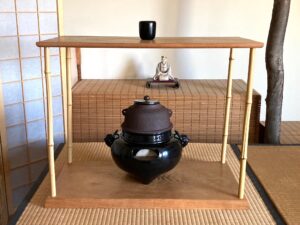
Furo naka-oki, 風炉中置, Wind-hearth middle-place; dai-su, 竹台, support-of. During this manner of preparing Tea, the furo is placed in the middle of the daisu on the ji-ita, 地板, earth-board. There are many variations.
The furo has its origins in the kō-ro, 香炉, incense-hearth, used in the Buddhist tradition. The kōro is placed in the middle of the Altar with a flower container on the left and a candlestick on the right. The central kōro is placed directly in front of deity. When placing the furo on the jiita of the daisu it is emulating the Buddhist kōro. Incense is essential to Buddhism just as it is in Chanoyu. Incense is placed in the furo and in the ro prior to guests entering the Tearoom, which indicates that the Tea is a Buddhist experience. Incense is placed in hearth just before the putting is the shita-bi, 下火, down-fire. This incense is called shiki-kō, 敷香, spread-incense.
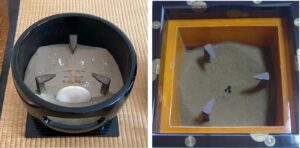
Shiki-kō, 敷香, spread-incense, is placing incense in the hearth prior to the charcoal fire shita-bi, 下火, down-fire, is placed in the hearth. Three squares of byaku-dan, 白檀, white-sandalwood, is placed in the furo on the trigram ☵, Kan, 坎, Hole, is symbolic of water, drawn in the middle of the ash bed. Three pellets of neri-kō, 練香, knead-incense, a blend of aromatics is placed in the center of the ash bed in the ro-dan, 炉壇, hearth-foundation.
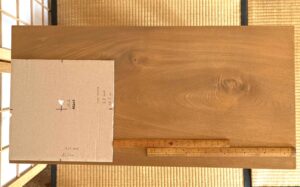
Rikyū’s take dai-su, 竹台子, bamboo stand-of, as seen from above measures 10 x 20 sun kujira-jaku, has aspects that may have a connection with the size of Rikyū’s small arame-ita. The shiki-ita measurements are 8.2 x 8.6 sun kane-jaku. These are unusual numbers, and seem to be arbitrary. Almost nothing is arbitrary in Chanoyu, and with connections to Ri-kyū Ko-ji, 利休居士, Rich-quit Is-gentleman.
Pictured above is the ten-ita of the take daisu, which measures 2 shaku kujira-jaku, or 20 sun kujira-jaku, or 25 sun kane-jaku. The piece of cardboard in the left near corner of the daisu tenita is the size of Rikyū’s large arame-ita – length 9.14 kane jaku.
Rikyū’s take dai-su, 竹台子, bamboo stand-of, as seen from above measures 10 x 20 sun kujira-jaku, has aspects that may have a connection with the size of Rikyū’s small arame-ita. The shiki-ita measurements are 8.2 x 8.6 sun kane-jaku. These are unusual numbers, and seem to be arbitrary. Almost nothing is arbitrary in Chanoyu, and with connections to Ri-kyū Ko-ji, 利休居士, Rich-quit Is-gentleman.
Pictured above is the ten-ita of the take daisu, which measures 2 shaku kujira-jaku, or 20 sun kujira-jaku, or 25 sun kane-jaku. The piece of cardboard in the left near corner of the daisu tenita is the size of Rikyū’s large arame-ita – length 9.14 kane jaku.
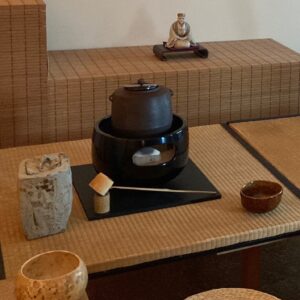
The ō-ita, 大板, large-board, is so-called because of its size, has its origins the square board cut in the floor to accommodate the presence of the sunken ro, 炉, hearth. The size of the square opening of the ro was determined at 14 sun kane-jaku by Sen no Rikyū. Before Rikyū, the ro had been in use, and its size appropriate for a particular kama. The kama may have come from the large furo of a temple, such as Rikyu’s ‘Amida-dō’ gama, 阿弥陀堂釜, Praise-increase-steep-hall kettle.
A replica of the floor board was made, lacquered black, and identified as an ō-ita, 大板, large-board. It is used to support a furo in the Tearoom, and provides a place for the futa-oki, 蓋置, lid-place, for the kama no futa, 窯の蓋, kettle’s lid, and the bamboo hi-shaku, 柄杓, handle-ladle, to dispense water. The ōita is most often used in the 10th month in the Tea presentation called Naka-oki, 中置, Middle-place.
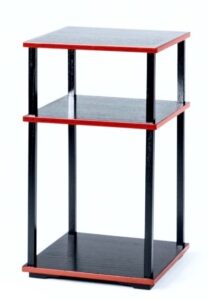
Variations of the daisu are display stands called tana, 棚, shelf, and joku, 卓, table. Perhaps the most familiar is the ni-ju dana, 二重棚, two-tier-shelf, named ‘Kō-kō dana’, 更好棚, Again-choose-shelf, which was designed by Gen-gen-sai, 玄々斎, Mystery-mystery-abstain, XI Iemoto, Urasenke. Gengensai was inspired by Rikyū’s san-jū-dana, 三重棚, three-tier-shelf, and removed one of the three upper shelves.
The two-tier tana shelves are one kane-jaku square, or 8 sun kane-jaku, and the full height is 14 sun kujira-jaku, or 17.5 sun kane-jaku.
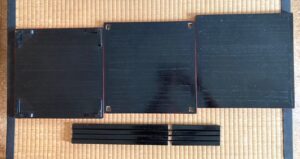
Disassembled parts of the ‘Kō-kō dana’, 更好棚, Again-choose-shelf. The pictured tatami is Kyō tatami that has a width of 31.25 sun kane-jaku.
The three boards each measure one kane-jaku square. Each board laid side by side measures three shaku kane-jaku, which is equal to the width of chū-Kyō tatami – 30 sun kane-jaku or 24 sun kujira-jaku. The visible length of the long post is 8.3 sun kujira-jaku, and the short post length is 4.1 sun kujira-jaku.
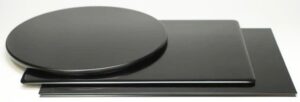
Three usu-ita, 薄板, thin-board, shin-nuri, 真塗, true-lacquer, from left:
Maru Kō-dai, 丸香台, round-incense-support; diam. 10 sun kane-jaku. Used with small Raku ceramic copies of Chinese forms, etc.
Hamaguri-ba, 蛤端, clam-edge; 9.5 x 15 sun kane-jaku. Used with gyō hana-ire, 行花入, transition flower-receptacles – Japanese glazed ceramic.
Ya-hazu ita, 矢筈板, arrow-nock board; 9.5 x 13.5 sun kane-jaku. Used with shin hana-ire, 真花入, true flower-receptacles – Chinese bronze, porcelain, etc.
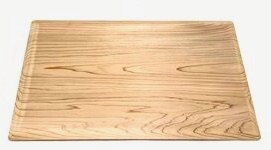
Usu-ita, 薄板, thin-board, ‘sugi-ba’, 杉葉, cedar-leaf, 10.8 x 7.4 sun kujira-jaku. This board is used with sō hana-ire, 草花入, grass flower-receptacles.
The sugi-ba is the same size as the shin-nuri hamaguri-ba usu-ita, 真塗 蛤端 薄板, true-lacquer clam-edge thin-board.
Hana-ire, 花入, flower-receptacle, that are wet and displayed in a tokonoma that has tatami flooring are displayed on the plain wood sugi-hamaguri-ba, 杉蛤端, cedar-leaf, which is also made wet.
Sugi, 杉, cedar, deodara, is said to be the ‘wood of the gods’, and has been used in natural medicine for millennia. It has a wide variety of uses to treat internally and externally for respiratory issues, joint pain, and to purify the environment. Almost all of its parts are used, including leaves, bark, timber, and berries, in various forms like teas, storage boxes, incense and incense containers etc.
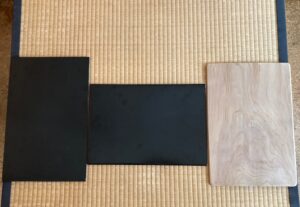
Three usu-ita, 薄板, thin-board, laid side by side across the width of Kyō-tatami which measures 2.5 shaku kujira-jaku. From left:
Yahazu ita; W. 7.2 sun kujira (9 sun kane); 11.2 sun kujira (14 sun kujira)
Hamaguri ita; W. 7.2 sun kujira (9 sun kane); 10.4 sun kujira (12.5 sun kane)
Sugi-ba; W. 7.4 sun kujira (9.25 sun kane) x 10.8 sun kujira (13.5 sun kane)
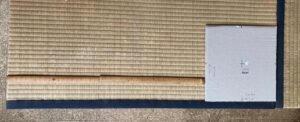
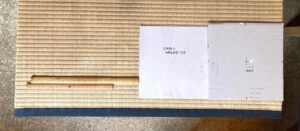
Rikyū’s large arame-ita dimensions are 8.8 x 9.14 sun kane-jaku, or 7.04 x 7.31 sun kujira-jaku. These are unusual numbers, except for the 8.8 which is symbolic of Infinity, emblematic of the center of the world, and the yojōhan chashitsu. Kyō-tatami has a width of 25 sun kujira or 31.25 sun kane. The length of one kujira-jaku plus one kane-jaku subtracted from 25 sun kujira leaves 7 sun kujira-jaku or 8.75 sun kane-jaku, and is very close to 8.8 sun kane-jaku.
The tatami in the picture above on the left is Kyō tatami, 25 sun kujira-jaku. The end of the kane-jaku ruler is located at 30 sun kane-jaku, establishing the width of chū-Kyō tatami. The large arame-ita, 8.8 sun kane-jaku, is equal to the space between the knee line of the teishu and the front edge of the arame shiki-ita. The small arame-ita width is 8.2 sun kane-jaku.
The tatami in the picture above on the right shows the widths of the two arame boards added together for a total of 17 sun kane-jaku. When placed on chū-Kyō tatami, 30 sun kane, leaves 13 sun kane. These measurements could indicate that the large arame-ita is more suited to Kyō tatami, and that the small arame-ita is more suited to chū–Kyō tatami. The expression ‘Cha Zen ichi mi’ relates Tea and Buddhism, and for a Buddhist the number jū-san, 十三, ten-three, could evoke thoughts of Jū-san Butsu, 十三仏, Thirteen Buddhas.

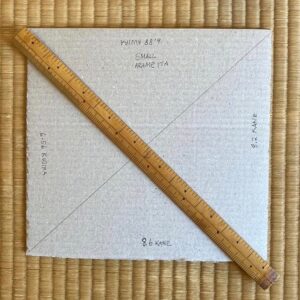
Left: large arame-ita with kujira-jaku ruler. Right: small arame-ita with kujira-jaku ruler.
The diagonal measurement of the large arame-ita is one shaku kujira-jaku plus 1.4 bu kujira. It appears that the original intention was to have the diagonal measurement at one shaku kujira. The length of the diagonal of the small arame-ita is 9.5 sun kujira-jaku. The 9.5 is familiar in Chanoyu: 9.5 sun kane-jaku is the length of hibashi. The number 9.5 in Japanese may be read kyū-go, and could be a homonym for kyū-go, 救護, salvation-protect, which is in Buddhism is to take refuge.
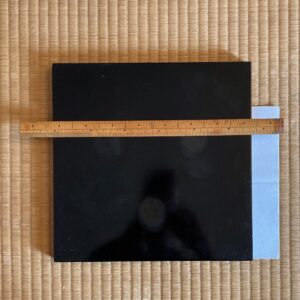
A black lacquered shiki-ita, 敷板, spread-board, laid over a sheet of kami kama-shiki, 紙釜敷, paper kettle-spread. The two spreads appear to be of the same size, but are not, and have some connections.
Shown above is a ‘standard’ shiki-ita which measures 9.5 x 9.5 sun kane-jaku, and has a perimeter of 38 sun kane-jaku. This translates to 7.6 x 7.6 sun kujira-jaku, with a perimeter of 30.4 sun kujira-jaku.
The unfolded paper under the board is a ‘standard’ kami kamashiki which measures 8.8 x 6 sun kujira-jaku, with a perimeter of 29.6 sun kujira-jaku (37 sun kane-jaku).
The ratio between the ita board and the kami paper is 29.6 / 30.4 sun kujira-jaku = 9.73:10.
The furo is placed on the shikiita, 敷板, spread-board, and its standard measurement is 9.5 sun kane-jaku square. The number 9.5 is the measurement of other Tea utensils, such as the length of the hi-bashi, 火箸, fire-rods, which move the pieces of the charcoal fire in the furo and ro. Another related object is the silk square with which the teishu purifies certain utensils, the fuku-sa, 帛紗, cloth-gauze.
The fukusa has measurements of 9 x 9.5 sun kane-jaku, which may also have associations with the shikitia. The fukusa can be of any color and design, while plain purple is for men and plain red is for women. The fukusa can be spread out in the tokonoma to display, and important object, and is essential to several Tea presentations called Kazari-mono, 荘物, Revere-thing. When displaying objects of importance in the tokonoma it may be seen as though the fukusa is acting as a type of ita, as fine objects have their own wooden bon, 盆, tray.

Various Tea utensils to be used in special Tea presentations called Kazari-mono, 荘物, Revered-thing, displayed on a fukusa as displayed in the tokonoma. Left: Cha-wan Kazari,茶碗荘, Tea-bowl Revere. Center: Cha-ire Kazari, 茶入荘, tea-receptacle revere. Right: Cha-shaku Kazari, 茶杓荘, tea-scoop revere.
Cha-wan, 茶碗, tea-bowl, wrapped in a purple silk go-motsu bukuro, 御物袋, hon,-thing-bag, displayed on an open fuku-sa, 帛紗, cloth-gauze, prior to its used in a Tea presentation called Cha-wan Kazari, 茶碗荘, Tea-bowl revere. The same display is presented when with a other prized utensils such as Cha-ire Kazari, 茶入荘, tea-receptacle revere, or Cha–shaku Kazari, 茶杓荘, tea-scoop revere, displayed in the tokonoma on an open purple silk fukusa.
The purple in Japanese is murasaki, 紫; purple gromwell, violet, Lithospermum erythrorhizon. The Kanji is also read shi. Purple is almost the most negative color visible to the naked human eye. The color to its most extreme is ultraviolet. Purple is an In, 陰, Ying color. Red, the opposite of purple, in its most extreme nature is infrared, the most positive Yō, 陽, Yang, color and invisible to the naked human eye.
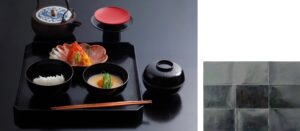
Pictured on the left is an o-shiki, 折敷, fold-spread, tray, Chanoyu. Pictured on the right is a ha-ttan, 鉢単, bowl-nest, Buddhist meal mat.
There are a wide variety of trays called o-shiki, 折敷, fold-spread, which should be read ori-shiki, but is not. Part of the origin of the oshiki is ha-ttan, 鉢単, bowl-nest, used as a food placemat in Buddhist food service called ō-ryō-ki, 応量器, accept-amount-container.
The oshiki pictured above is used in a cha-ji, 茶事, tea-matter: one shaku kane-jaku square. The corners are mitered to create eight sides, and the number 8 hachi, 八, is symbolic of Infinity in Space. The Buddhist hattan is 8 x 10 sun kane-jaku, and is folded for ease of handling, which creates nine rectangles – one surrounded by eight. The nine squares are emblematic of the Kongōkai Mandara, 金剛界曼荼羅, Gold-strength-world Wide-weed-spread, a visualized depiction of the Buddhist realm of enlightenment. The nine squares are also found in the tatami arrangement of a yo-jō-han cha-shitsu, 四畳半, four-mat-half tea-room.
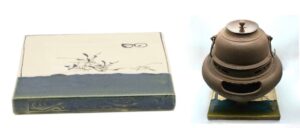
Left: shiki-gawara, 敷瓦, spread-board, square, ceramic tile with green glaze area and black line drawing, Ori-be yaki, 織部焼, Weave-guild fired. Right: fu-ro, 風炉, wind-hearth, supported on shiki-gawara, 敷瓦, spread-tile.
In Chanoyu, such tiles are used to support a portable fu-ro, 風炉, wind-hearth. Some Tea followers feel the most appropriate brazier for the shiki gawara, is a tetsu-bu-ro, 鉄風炉, iron wind-hearth.
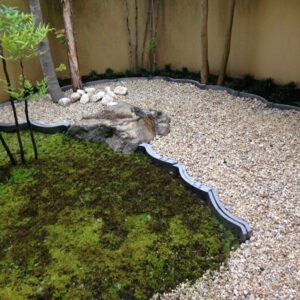
The tiles, perhaps originally roof tiles, form a barrier between areas of temple gardens. The origin of the shiki-gawara lends a humble appearance to the sō-an, 草庵, grass-hut, or supporting a kama in the mizu-ya, 水屋, water-room. Shiki gawara are also made in the ceramic wares of Shi-no, 志野, Aspire-field, Shiga-raki, 信楽, Faith-pleasure, Tan-ba, 丹波, Red-wave, etc.
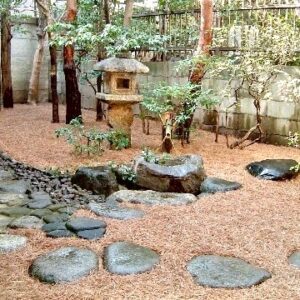
Shiki matsu-ba, 敷松葉, spread pine-leaves; pine needles and gather and layered over patches in the garden to protect the moss ground cover from the cold and snow.
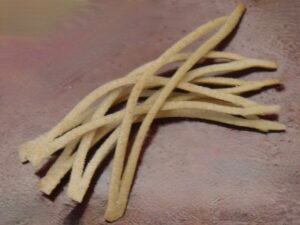
Matsu-ba, 松葉, pine-leaves, hi-ga-shi, 干菓子, dry-sweet-of, sweetened buckwheat strips cut to resemble fallen pine needles – served with tea. Similar dry sweets are made by countless confectionaries, as well as people on their own.
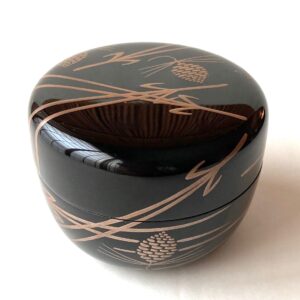
Hira-natsume, 平棗, wide-jujube; black-lacquered wood with gold maki-e, 蒔絵, embed-picture, of matsu-kasa matsu-ba, 松笠松葉, pine-cone pine-leaf, by Naka-mura Sō-tetsu, 中村宗哲, Middle-town Sect-philosophy, Kyōto; choice of Hōunsai.
Fallen pine needles are emblematic of the end of life, and the pine cones filled with seeds are emblematic of the beginning of life. The two-tine pine needle are symbolic of sue-hiro, 末広, ends-wide, which is like Infinity in Space. The round pine cones are the counterpart of the straight lines of the needles, emphasizing their In and Yō aspects. The ball can roll about unimpeded for ever, which is emblematic of Infinity in Time. Nature leaves the fallen needles to nourish new growth, spread over the ground. Nature’s own shiki matsuba.
Wordplay is a prominent feature in Japanese culture. The word shiki has multiple meanings, such as 色, color, form, 識, consciousness/knowledge, 式, ritual or rite, as in Ken-cha-shiki, 献茶式, Offering-tea-rite, in the tearoom. For example, in Chanoyu there is the Shichjishiki.

Shichi-ji-shiki, 七事式, Seven-matter-rites, are Tea presentations that involve group participation. The Shichi–ji-shiki, were created by Jo-shin-sai, 如心斎, the 7th iemoto of Omote-sen-ke, 表千家, and Yu-gen-sai I-ttō, 又玄斎一燈, Again-mystery One-light, the 8th head of the Urasenke, and others to enrich the spirit and technique of tea ceremony. The seven ceremonies are collectively known by the first of the group, Ka-getsu, 花月, Flower-moon. Proceedings include activities such as making thick tea, making thin tea, arranging the charcoal fire, presenting flowers, writing poetry, etc., almost every aspect of Chanoyu can be seen in the various Kagetsu practices. Selection and order is, in part, determined by a random selection and use of small bamboo fuda, 札, cards, that are held in a stiff paper ori-sue, 折据, fold-equip. After the original seven practices, an additional seven ceremonies were created by successive Iemoto. Following Urasenke tradition, each Iemoto creates a different ceremony that is presented for the first time at his funeral.
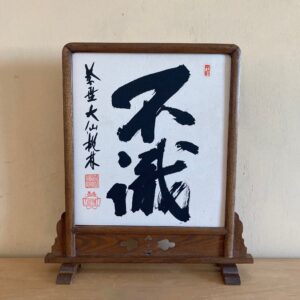
Shikishi as seen in the machiai that reads ‘Fu-shiki’, 不識, No-consciousness, written by O-zeki Tō-rin, 尾関桃林, Tail-barrier Peach-grove, abbot of Dai-sen-zen-in, 大仙禅院, Great-hermit-Zen-temple, a sub-temple of Dai-toku-ji, 大徳寺, Great-virtue-temple, Kyōto. Signed: Murasaki-no Dai-sen Tō-rin, 紫野大仙桃林, Purple-rice field Great-hermit Peach-grove, and red ink stamps for the temple and the author.
A major homonym of shiki, 敷, spread, is shiki, 色, color, as for the word shiki-shi, 色紙, color-paper, which are pasteboard ‘squares’ for writing and pictures, like the shikishi above. The Kanji on the shikishi is another homonym, shiki, 識, consciousness, in the expression uttered by Daruma, ‘Fu-shiki’, 不織, consciousness.
For further study, see also: Kuro: The Color Black in Chanoyu and Nakaoki Ōita

